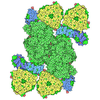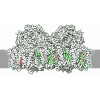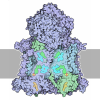[English] 日本語
 Yorodumi
Yorodumi- PDB-8xlp: Structure of inactive Photosystem II associated with CAC antenna ... -
+ Open data
Open data
- Basic information
Basic information
| Entry | Database: PDB / ID: 8xlp | |||||||||||||||||||||
|---|---|---|---|---|---|---|---|---|---|---|---|---|---|---|---|---|---|---|---|---|---|---|
| Title | Structure of inactive Photosystem II associated with CAC antenna from Rhodomonas Salina | |||||||||||||||||||||
 Components Components |
| |||||||||||||||||||||
 Keywords Keywords | PHOTOSYNTHESIS / Photosystem II associated with CAC antenna from Rhodomonas Salina | |||||||||||||||||||||
| Function / homology |  Function and homology information Function and homology informationphotosystem II stabilization / photosystem II reaction center / photosystem II / oxidoreductase activity, acting on diphenols and related substances as donors, oxygen as acceptor / photosynthetic electron transport chain / photosystem II / response to herbicide / chlorophyll binding / photosynthetic electron transport in photosystem II / : ...photosystem II stabilization / photosystem II reaction center / photosystem II / oxidoreductase activity, acting on diphenols and related substances as donors, oxygen as acceptor / photosynthetic electron transport chain / photosystem II / response to herbicide / chlorophyll binding / photosynthetic electron transport in photosystem II / : / phosphate ion binding / chloroplast thylakoid membrane / photosynthesis / oxidoreductase activity / electron transfer activity / protein stabilization / iron ion binding / heme binding / metal ion binding Similarity search - Function | |||||||||||||||||||||
| Biological species |  Rhodomonas salina (eukaryote) Rhodomonas salina (eukaryote) | |||||||||||||||||||||
| Method | ELECTRON MICROSCOPY / single particle reconstruction / cryo EM / Resolution: 2.57 Å | |||||||||||||||||||||
 Authors Authors | Si, L. / Li, M. | |||||||||||||||||||||
| Funding support |  China, 1items China, 1items
| |||||||||||||||||||||
 Citation Citation |  Journal: Nat Commun / Year: 2024 Journal: Nat Commun / Year: 2024Title: Structural basis for the distinct core-antenna assembly of cryptophyte photosystem II. Authors: Long Si / Shumeng Zhang / Xiaodong Su / Mei Li /  Abstract: Photosystem II (PSII) catalyzes the light-driven charge separation and water oxidation reactions of photosynthesis. Eukaryotic PSII core is usually associated with membrane-embedded light-harvesting ...Photosystem II (PSII) catalyzes the light-driven charge separation and water oxidation reactions of photosynthesis. Eukaryotic PSII core is usually associated with membrane-embedded light-harvesting antennae, which greatly increase the absorbance cross-section of the core. The peripheral antennae in different phototrophs vary considerably in protein composition and arrangement. Photosynthetic cryptophytes possess chlorophyll a/c binding proteins (CACs) that serve as their antennae. How these CACs assemble with the PSII core remains unclear. Here, we report the 2.57-Å resolution structure of cryptophyte PSII-CAC purified from cells at nitrogen-limited stationary growth phase. We show that each monomer of the PSII homodimer contains a core complex, six chlorophyll a/c binding proteins (CACs) and a previously unseen chlorophyll-binding protein (termed CAL-II). Six CACs are arranged as a double-layered arc-shaped non-parallel belt, and two such belts attach to the dimeric core from opposite sides. The CAL-II simultaneously interacts with a number of core subunits and five CACs. The distinct organization of CACs and the presence of CAL-II may play a critical role in stabilizing the dimeric PSII-CAC complex under stress conditions. Our study provides mechanistic insights into the assembly and function of the PSII-CAC complex as well as the possible adaptation of cryptophytes in response to environmental stresses. | |||||||||||||||||||||
| History |
|
- Structure visualization
Structure visualization
| Structure viewer | Molecule:  Molmil Molmil Jmol/JSmol Jmol/JSmol |
|---|
- Downloads & links
Downloads & links
- Download
Download
| PDBx/mmCIF format |  8xlp.cif.gz 8xlp.cif.gz | 1.7 MB | Display |  PDBx/mmCIF format PDBx/mmCIF format |
|---|---|---|---|---|
| PDB format |  pdb8xlp.ent.gz pdb8xlp.ent.gz | 1.5 MB | Display |  PDB format PDB format |
| PDBx/mmJSON format |  8xlp.json.gz 8xlp.json.gz | Tree view |  PDBx/mmJSON format PDBx/mmJSON format | |
| Others |  Other downloads Other downloads |
-Validation report
| Summary document |  8xlp_validation.pdf.gz 8xlp_validation.pdf.gz | 16.5 MB | Display |  wwPDB validaton report wwPDB validaton report |
|---|---|---|---|---|
| Full document |  8xlp_full_validation.pdf.gz 8xlp_full_validation.pdf.gz | 17.5 MB | Display | |
| Data in XML |  8xlp_validation.xml.gz 8xlp_validation.xml.gz | 340.9 KB | Display | |
| Data in CIF |  8xlp_validation.cif.gz 8xlp_validation.cif.gz | 408.4 KB | Display | |
| Arichive directory |  https://data.pdbj.org/pub/pdb/validation_reports/xl/8xlp https://data.pdbj.org/pub/pdb/validation_reports/xl/8xlp ftp://data.pdbj.org/pub/pdb/validation_reports/xl/8xlp ftp://data.pdbj.org/pub/pdb/validation_reports/xl/8xlp | HTTPS FTP |
-Related structure data
| Related structure data |  38455MC M: map data used to model this data C: citing same article ( |
|---|---|
| Similar structure data | Similarity search - Function & homology  F&H Search F&H Search |
- Links
Links
- Assembly
Assembly
| Deposited unit | 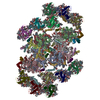
|
|---|---|
| 1 |
|
- Components
Components
-Photosystem II ... , 14 types, 28 molecules aAbBcCdDhHiIkKlLmMtTwWxXyYzZ
| #1: Protein | Mass: 36342.285 Da / Num. of mol.: 2 / Source method: isolated from a natural source / Source: (natural)  Rhodomonas salina (eukaryote) / References: UniProt: A6MVT2, photosystem II Rhodomonas salina (eukaryote) / References: UniProt: A6MVT2, photosystem II#2: Protein | Mass: 56331.055 Da / Num. of mol.: 2 / Source method: isolated from a natural source / Source: (natural)  Rhodomonas salina (eukaryote) / References: UniProt: A6MW31 Rhodomonas salina (eukaryote) / References: UniProt: A6MW31#3: Protein | Mass: 53609.383 Da / Num. of mol.: 2 / Source method: isolated from a natural source / Source: (natural)  Rhodomonas salina (eukaryote) / References: UniProt: A6MVR2 Rhodomonas salina (eukaryote) / References: UniProt: A6MVR2#4: Protein | Mass: 39220.824 Da / Num. of mol.: 2 / Source method: isolated from a natural source / Source: (natural)  Rhodomonas salina (eukaryote) / References: UniProt: A6MVR3, photosystem II Rhodomonas salina (eukaryote) / References: UniProt: A6MVR3, photosystem II#7: Protein | Mass: 7429.764 Da / Num. of mol.: 2 / Source method: isolated from a natural source / Source: (natural)  Rhodomonas salina (eukaryote) / References: UniProt: A6MW35 Rhodomonas salina (eukaryote) / References: UniProt: A6MW35#8: Protein/peptide | Mass: 4390.065 Da / Num. of mol.: 2 / Source method: isolated from a natural source / Source: (natural)  Rhodomonas salina (eukaryote) / References: UniProt: A6MVW0 Rhodomonas salina (eukaryote) / References: UniProt: A6MVW0#9: Protein/peptide | Mass: 5025.104 Da / Num. of mol.: 2 / Source method: isolated from a natural source / Source: (natural)  Rhodomonas salina (eukaryote) / References: UniProt: A6MVZ3 Rhodomonas salina (eukaryote) / References: UniProt: A6MVZ3#10: Protein/peptide | Mass: 4363.087 Da / Num. of mol.: 2 / Source method: isolated from a natural source / Source: (natural)  Rhodomonas salina (eukaryote) / References: UniProt: A6MVV3 Rhodomonas salina (eukaryote) / References: UniProt: A6MVV3#11: Protein/peptide | Mass: 4300.023 Da / Num. of mol.: 2 / Source method: isolated from a natural source / Source: (natural)  Rhodomonas salina (eukaryote) Rhodomonas salina (eukaryote)#12: Protein/peptide | Mass: 3708.500 Da / Num. of mol.: 2 / Source method: isolated from a natural source / Source: (natural)  Rhodomonas salina (eukaryote) / References: UniProt: A6MW32 Rhodomonas salina (eukaryote) / References: UniProt: A6MW32#13: Protein | Mass: 7864.871 Da / Num. of mol.: 2 / Source method: isolated from a natural source / Source: (natural)  Rhodomonas salina (eukaryote) Rhodomonas salina (eukaryote)#14: Protein/peptide | Mass: 4192.965 Da / Num. of mol.: 2 / Source method: isolated from a natural source / Source: (natural)  Rhodomonas salina (eukaryote) / References: UniProt: A6MVU5 Rhodomonas salina (eukaryote) / References: UniProt: A6MVU5#15: Protein/peptide | Mass: 3662.478 Da / Num. of mol.: 2 / Source method: isolated from a natural source / Source: (natural)  Rhodomonas salina (eukaryote) / References: UniProt: A6MVU9 Rhodomonas salina (eukaryote) / References: UniProt: A6MVU9#16: Protein | Mass: 6656.092 Da / Num. of mol.: 2 / Source method: isolated from a natural source / Source: (natural)  Rhodomonas salina (eukaryote) / References: UniProt: A6MVZ2 Rhodomonas salina (eukaryote) / References: UniProt: A6MVZ2 |
|---|
-Cytochrome b559 subunit ... , 2 types, 4 molecules eEfF
| #5: Protein | Mass: 9503.720 Da / Num. of mol.: 2 / Source method: isolated from a natural source / Source: (natural)  Rhodomonas salina (eukaryote) / References: UniProt: A6MVV5 Rhodomonas salina (eukaryote) / References: UniProt: A6MVV5#6: Protein/peptide | Mass: 4860.847 Da / Num. of mol.: 2 / Source method: isolated from a natural source / Source: (natural)  Rhodomonas salina (eukaryote) / References: UniProt: A6MVV4 Rhodomonas salina (eukaryote) / References: UniProt: A6MVV4 |
|---|
-Protein , 7 types, 14 molecules gG2O3P4Q5R6S1N
| #17: Protein | Mass: 30760.855 Da / Num. of mol.: 2 / Source method: isolated from a natural source / Source: (natural)  Rhodomonas salina (eukaryote) Rhodomonas salina (eukaryote)#18: Protein | Mass: 23912.699 Da / Num. of mol.: 2 / Source method: isolated from a natural source / Source: (natural)  Rhodomonas salina (eukaryote) Rhodomonas salina (eukaryote)#19: Protein | Mass: 23723.541 Da / Num. of mol.: 2 / Source method: isolated from a natural source / Source: (natural)  Rhodomonas salina (eukaryote) Rhodomonas salina (eukaryote)#20: Protein | Mass: 23111.850 Da / Num. of mol.: 2 / Source method: isolated from a natural source / Source: (natural)  Rhodomonas salina (eukaryote) Rhodomonas salina (eukaryote)#21: Protein | Mass: 24738.434 Da / Num. of mol.: 2 / Source method: isolated from a natural source / Source: (natural)  Rhodomonas salina (eukaryote) Rhodomonas salina (eukaryote)#22: Protein | Mass: 24792.469 Da / Num. of mol.: 2 / Source method: isolated from a natural source / Source: (natural)  Rhodomonas salina (eukaryote) Rhodomonas salina (eukaryote)#23: Protein | Mass: 25265.215 Da / Num. of mol.: 2 / Source method: isolated from a natural source / Source: (natural)  Rhodomonas salina (eukaryote) Rhodomonas salina (eukaryote) |
|---|
-Sugars , 1 types, 4 molecules 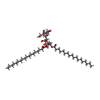
| #35: Sugar | ChemComp-DGD / |
|---|
-Non-polymers , 16 types, 368 molecules 
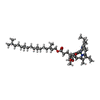

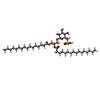

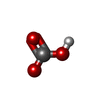
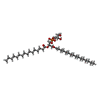


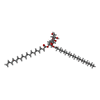
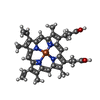


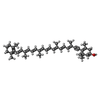















| #24: Chemical | | #25: Chemical | ChemComp-CLA / #26: Chemical | ChemComp-PHO / #27: Chemical | ChemComp-WVN / Mass: 536.873 Da / Num. of mol.: 24 / Source method: obtained synthetically / Formula: C40H56 #28: Chemical | ChemComp-SQD / #29: Chemical | ChemComp-PL9 / #30: Chemical | #31: Chemical | ChemComp-LHG / #32: Chemical | ChemComp-CL / #33: Chemical | ChemComp-MN / #34: Chemical | ChemComp-LMG / #36: Chemical | #37: Chemical | ChemComp-KC2 / #38: Chemical | ChemComp-II0 / ( |
|---|
 Movie
Movie Controller
Controller




 PDBj
PDBj